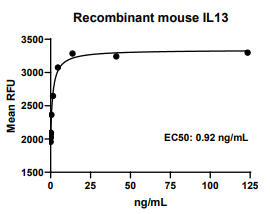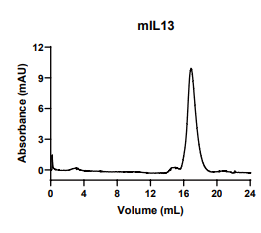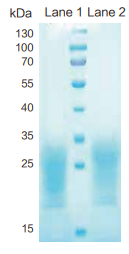Cat: MF-1013
Cat: MF-1013
IL13, Mouse, HEK293 Cells,Tag Free: Product Information
P20109
Human embryonic kidney cell, HEK293-derived mouse IL-13 protein Ser26-Phe131
11.5 kDa
Solution protein.
Dissolved in sterile PBS buffer. This solution can be diluted into other aqueous buffers. Centrifuge the vial prior to opening.
Use a manual defrost freezer and avoid repeated freeze-thaw cycles. It is recommended that the protein be aliquoted for optimal storage. 12 months from date of receipt, -20 to -70 °C as supplied.
Shipping with dry ice.
> 95%, determined by SDS-PAGE.
<0.010 EU per 1 ug of the protein by the LAL method.
Measured in a cell proliferation assay using TF-1 human erythroleukemic cells. The EC50 for this effect is 0.5-1.5 ng/mL.
IL13, Mouse, HEK293 Cells,Tag Free:SDS-PAGE & Bioactivity
IL13, Mouse, HEK293 Cells,Tag Free:Synonyms
ALRHMGC116789; BHR1interleukin-13; IL13; IL-13; IL-13MGC116788; interleukin 13
IL13, Mouse, HEK293 Cells,Tag Free:Background
Interleukin-13 (IL-13) , is a 17 kDa immunoregulatory cytokine that plays a key role in the pathogenesis of allergic asthma and atopy. It is secreted by Th1 and Th2 CD4+ T cells, NK cells, visceral smooth muscle cells, eosinophils, mast cells, and basophils (1 - 3). IL-13 circulates as a monomer with two
internal disulfide bonds that contribute to a bundled four alpha -helix configuration (4, 5). Mature mouse IL-13 shares 57%, 75%, and 58% amino acid
sequence identity with human, rat, and rhesus IL-13, respectively. Despite the low homology, it exhibits cross-species activity between human, mouse,
and rat (6, 7). IL-13 has diverse activities on numerous cell types (8). On macrophages, IL-13 suppresses the production of proinflammatory cytokines
and other cytotoxic substances. On B cells, IL-13 induces immunoglobulin class switching to IgE, upregulates the expression of MHC class II, CD71, CD72,and CD23, and costimulates proliferation. IL-13 upregulates IL-6 while downregulating IL-1 and TNF-alpha production by fibroblasts and endothelial cells.
1. Wills-Karp, M. (2004) Immunol. Rev. 202:175.
2. Nakajima, H. and K. Takatsu (2007) Int. Arch. Allergy Immunol. 142:265.
3. Brown, K.D. et al. (1989) J. Immunol. 142:679.
4. Moy, F.J. et al. (2001) J. Mol. Biol. 310:219.
5. Eisenmesser, E.Z. et al. (2001) J. Mol. Biol. 310:231.
6. Ruetten, H. and C. Thiemermann (1997) Shock 8:409.
7. Lakkis, F.G. et al. (1997) Biochem. Biophys. Res. Commun. 235:529.
8. Wynn, T.A. (2003) Annu. Rev. Immunol. 21:425.










